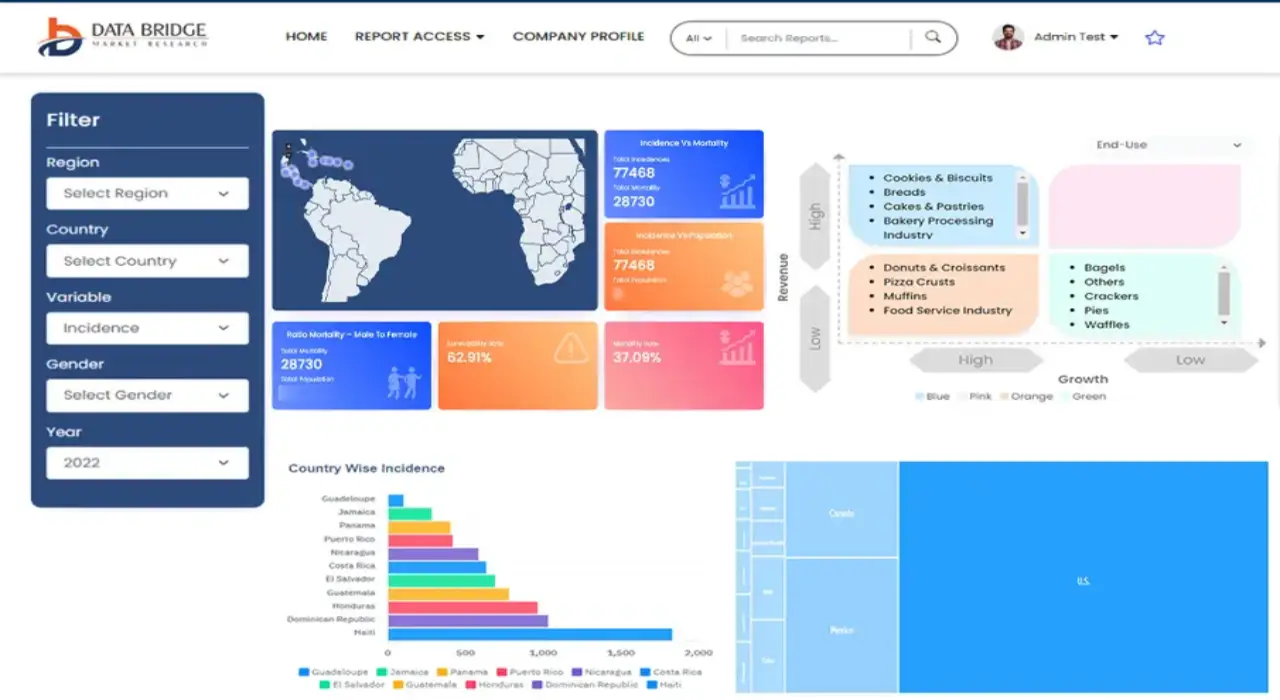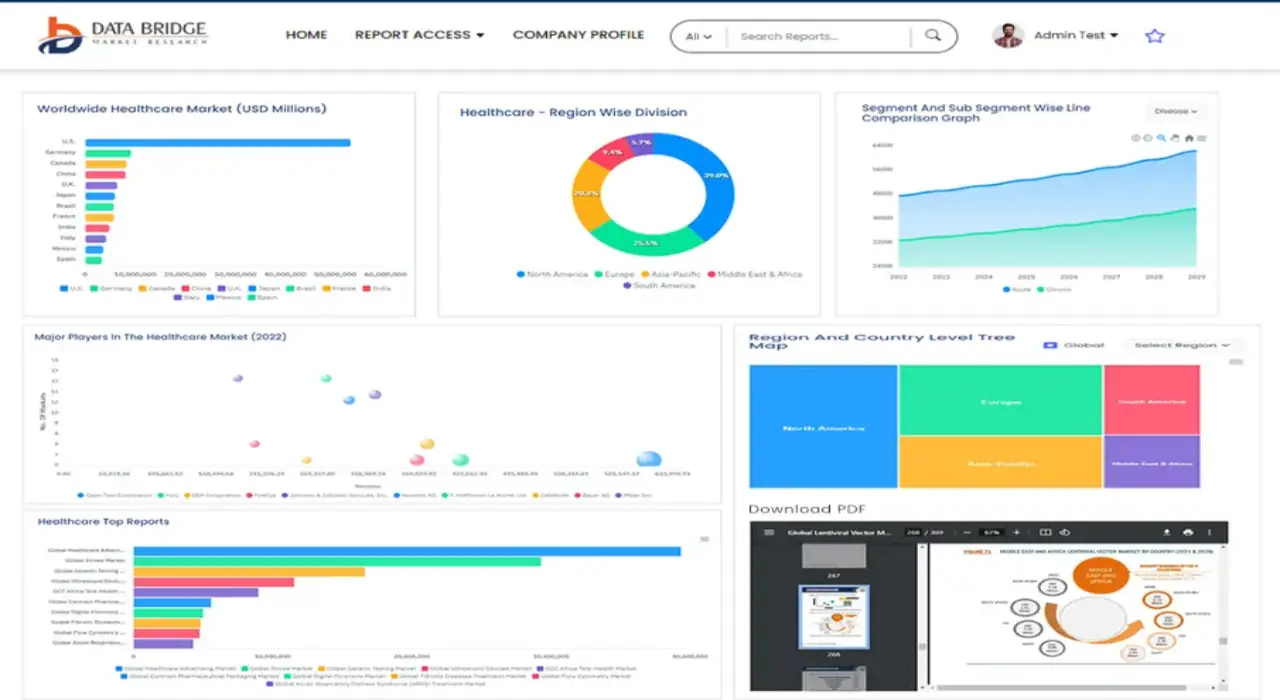Global Panic Disorders Market
Tamanho do mercado em biliões de dólares
CAGR :
% 
 USD
9.58 Billion
USD
13.17 Billion
2022
2030
USD
9.58 Billion
USD
13.17 Billion
2022
2030
| 2023 –2030 | |
| USD 9.58 Billion | |
| USD 13.17 Billion | |
|
|
|
>Global Panic Disorders Market, By Type (Agoraphobia, Social Anxiety Disorder (SAD), Obsessive-Compulsive Disorder (OCD), Bipolar Disorder, Post-Traumatic Stress Disorder (PTSD), Specific Phobias, Generalized Anxiety Disorder (GAD), Major Depressive Disorder (MDD)), Therapy and Devices (Electroconvulsive Therapy ECT, Cognitive-Behavioral Therapy (CBT)), Drug Class (Benzodiazepines (BZD), Serotonin-Norepinephrine Reuptake Inhibitor (SNRI), Monoamine Oxidase Inhibitors (MAOIs), Anti-Depressants, Tricyclic Antidepressants (TCAs), Pregabalin, Buspirone, Sertraline), Distribution Channel (Pharmacies, Drug Stores, E-Commerce, Online, Offline), (Administration Oral, Parenteral, Others), Treatment (Medication, Beta Blockers, Serotonin and Norepinephrine Reuptake Inhibitors (SNRIs), Benzodiazepines, Anti-epilepsy, Others), Dosage (Tablets, Injections, Others), End-User (Hospitals, Mental Healthcare Centres, Asylums, Others) – Industry Trends and Forecast to 2030.
Panic Disorders Market Analysis and Size
People consequently experience stress, tension, and burden. Shortness of breath, sweating, trembling, nausea, heart palpitations, and numbness are all signs of panic disorders. Treatment options for panic disorders include therapy, medication, and psychological approaches. Although not life-threatening, panic attacks can still harm one's anxiety disorder, which aids in the creation of targeted therapies to treat them. The deregulation of the gene NTRK3 causes the fear-related memory system to malfunction, which is what causes panic disorder.
Data Bridge Market Research analyses that the panic disorders market, valued at USD 9.58 billion in 2022, will reach USD 13.17 billion by 2030, growing at a CAGR of 4.06% during the forecast period of 2023 to 2030. The market report curated by the Data Bridge Market Research team includes in-depth expert analysis, patient epidemiology, pipeline analysis, pricing analysis, and regulatory framework. Type segment is dominating the global panic disorder market due to the availability of efficient treatment options. In growth In addition to the insights on market scenarios such as market value, growth rate, segmentation, geographical coverage, and major players, the market reports curated by the Data Bridge Market Research also include depth expert analysis, patient epidemiology, pipeline analysis, pricing analysis, and regulatory framework.
Panic Disorders Market Scope and Segmentation
|
Report Metric |
Details |
|
Forecast Period |
2023 to 2030 |
|
Base Year |
2022 |
|
Historic Years |
2021 (Customizable to 2015 - 2020) |
|
Quantitative Units |
Revenue in USD Billion, Volumes in Units, Pricing in USD |
|
Segments Covered |
By Type (Agoraphobia, Social Anxiety Disorder (SAD), Obsessive-Compulsive Disorder (OCD), Bipolar Disorder, Post-Traumatic Stress Disorder (PTSD), Specific Phobias, Generalized Anxiety Disorder (GAD), Major Depressive Disorder (MDD)), Therapy and Devices (Electroconvulsive therapy ECT, Cognitive-behavioral therapy (CBT)), Drug Class (Selective Serotonin Reuptake Inhibitor (SSRI), Benzodiazepines (BZD), Serotonin-Norepinephrine Reuptake Inhibitor (SNRI), Monoamine Oxidase Inhibitors (MAOIs), Anti-Depressants, Tricyclic Antidepressants (TCAs), Pregabalin, Buspirone, Sertraline), Distribution channel (Pharmacies, Drug Stores, E-Commerce, Online, Offline), (Administration Oral, Parenteral, Others), Treatment (Medication, Beta Blockers, Serotonin and Norepinephrine Reuptake Inhibitors (SNRIs), Benzodiazepines, Anti-epilepsy, Others), Dosage (Tablets, Injections, Others), End-User (Hospitals, Mental Healthcare Centres, Asylums, Others) |
|
Countries Covered |
U.S., Canada and Mexico in North America, Germany, France, U.K., Netherlands, Switzerland, Belgium, Russia, Italy, Spain, Turkey, Rest of Europe in Europe, China, Japan, India, South Korea, Singapore, Malaysia, Australia, Thailand, Indonesia, Philippines, Rest of Asia-Pacific (APAC) in the Asia-Pacific (APAC), Saudi Arabia, U.A.E, South Africa, Egypt, Israel, Rest of Middle East and Africa (MEA) as a part of Middle East and Africa(MEA), Brazil, Argentina and Rest of South America as part of South America. |
|
Market Players Covered |
Teva Pharmaceutical Industries Ltd. (Israel), Sun Pharmaceutical Industries Ltd. (India), Mylan N.V. (U.S.), AstraZeneca (U.K.), Abbott. (U.S.), Baxter. (U.S.), Bristol-Myers Squibb Company (U.S.), Eli Lilly and Company. (U.S.), F. Hoffmann-La Roche Ltd (Switzerland), GlaxoSmithKline plc (U.K.), Noven Pharmaceuticals, Inc. (U.S.), Pfizer Inc. (U.S.), Recordati S.p.A (Italy), Shionogi & Co., Ltd. (Japan), Sumitomo Pharma Co., Ltd (Japan), Boehringer Ingelheim International GmbH. (Germany), Bausch Health Companies Inc. (Canada), H. Lundbeck A/S (Denmark), Sanofi (France), Neurocrine Biosciences, Inc (U.S.), among others |
|
Market Opportunities |
|
Market Definition
Recurrent, irrational panic attacks characterize a mental and behavioral disorder called panic disorder. In addition to palpitations, sweating, shaking, shortness of breath, numbness, or the impression that something terrible is about to happen, a panic attack, also known as an acute onset of severe fear, can include other symptoms. Within minutes, sensations reach their peak intensity. Anxiety and fear attacks that come on suddenly and repeatedly are signs of a panic disorder. Panic disorders can be caused by stress and anxiety. Almost every person aspires to be at the top of the game in this fast-paced world. The intense competition in the market makes it difficult even to stay afloat. There may be ongoing concerns about possible attacks and avoiding places where incidents have previously occurred.
Panic Disorders Market Dynamics
Drivers
- Increasing Prevalence of Panic Disorders
The increasing prevalence of panic disorders in different parts of the world is an important market factor. Factors such as lifestyle changes, work-related stress, and increased awareness of mental health are increasing the number of people seeking diagnosis and treatment for panic disorders.
- Advancements in Treatment Options
The development of innovative treatment options, including medications, cognitive-behavioral therapies, and relaxation techniques, will contribute to the growth of the panic disorder market. Continuous research and technological development in the field lead to more effective and individualized treatment methods that expand the market.
- Growing Mental Health Awareness and Initiatives
Increasing public awareness about mental health issues, including panic disorders, and the efforts of governments, healthcare organizations, and advocacy groups to address mental health concerns are driving market growth. The rising recognition of panic disorders as a serious health condition is resulting in improved access to diagnosis and treatment options.
Opportunities
- Expansion in Telemedicine and Digital Interventions
The rapid development of telemedicine and digital health services offers opportunities for remote diagnosis, treatment, and monitoring of patients with panic disorders. These technologies increase accessibility, convenience, and cost-effectiveness, which opens up new opportunities for market growth.
- Rising Demand for Personalized Medicine and Targeted Therapies
The growing emphasis on personalized medicine and targeted therapies is a promising opportunity for the panic disorders market. Tailoring treatment options to individual patients based on their genetic profile, underlying causes, and specific symptoms can lead to improved efficacy and patient outcomes.
Restraints/Challenges
- High Stigma and Social Barriers
The stigma associated with mental health conditions, including panic disorders, remains a significant restraint for the market. Misconceptions, discrimination, and societal barriers often prevent individuals from seeking timely diagnosis and treatment, thereby hindering market growth.
- Limited Access to Mental Healthcare Services
The lack of access to mental healthcare services, particularly in low-income regions or underserved populations, poses a significant challenge for the panic disorders market. Limited availability of mental health professionals, inadequate infrastructure, and financial barriers can impede the diagnosis and treatment of panic disorders, affecting the overall market growth.
This Panic Disorders Market report provides details of new recent developments, trade regulations, import-export analysis, production analysis, value chain optimization, market share, impact of domestic and localized market players, analyses opportunities in terms of emerging revenue pockets, changes in market regulations, strategic market growth analysis, market size, category market growths, application niches and dominance, product approvals, product launches, geographic expansions, technological innovations in the market. To gain more info on the Panic Disorders Market contact Data Bridge Market Research for an Analyst Brief, our team will help you take an informed market decision to achieve market growth.
Recent Developments
- In 2022, patients with panic disorder, alone or in combination with the listed co-morbidities, are being studied in a multicenter, randomized, double-blind, and placebo-controlled Phase II trial. Between 18 and 60, male and female adult patients with panic disorder are enrolled in the study to compare the safety and efficacy of HB-1 to a placebo. By January 2023, completion is anticipated
- In 2022, top-line results from the Phase 2 Proof-of-Concept investigator-initiated trial of HMNC Brain Health's oral prolonged-release ketamine (KET01) formulation in treating treatment-resistant depression (TRD) were encouraging
- In 2021, the effectiveness of Xenon Inhalation in treating patients with panic disorder was investigated in a double-blind, randomized, and placebo-controlled phase II and phase III trial. The findings indicate that Xenon is a promising therapeutic option for treating panic disorder and that its anti-panic effects persist for at least six months after the active phase of therapy.
Global Panic Disorders Market Scope
The panic disorders market is segmented on the basis of type, therapy and devices, drug class, distribution channel, administration, treatment, dosage, and end-user. The growth amongst these segments will help you analyze meagre growth segments in the industries and provide the users with a valuable market overview and market insights to help them make strategic decisions for identifying core market applications.
Type
- Agoraphobia
- Social Anxiety Disorder (SAD)
- Obsessive-Compulsive Disorder (OCD)
- Bipolar Disorder
- Post-Traumatic Stress Disorder (PTSD)
- Specific Phobias
- Generalized Anxiety Disorder (GAD)
- Major Depressive Disorder (MDD)
Therapy and Devices
- Electroconvulsive therapy ECT
- Cognitive-behavioral therapy (CBT)
Drug Class
- Benzodiazepines (BZD)
- Serotonin-Norepinephrine Reuptake Inhibitor (SNRI)
- Monoamine Oxidase Inhibitors MAOIs
- Anti-Depressants
- Tricyclic Antidepressants (TCAs)
- Pregabalin
- Buspirone
- Sertraline
Distribution Channel
- Pharmacies
- Hospital Pharmacies
- Retail Pharmacies
- Drug Stores
- E-Commerce
- Online
- Offline
Administration
- Oral
- Parenteral
- Others
Treatment
- Medication
- Selective serotonin reuptake inhibitors (SSRIs)
- Fluoxetine
- Citalopram
- Paroxetine
- Paxil
- pexava
- Beta blockers
- Serotonin and norepinephrine reuptake inhibitors (SNRIs)
- Venlafaxine
- Benzodiazepines
- Alprazolam
- Clonazepam
- Anti-epilepsy
- Pregabalin
- Clonazepam
- Others
- Fischer Wallace Stimulator
- Transcranial magnetic stimulation (TMS)
- Deep Brain Stimulation (DBS)
- Vagus nerve stimulation (VNS)
- Atypical Antipsychotics
- Anticonvulsants
Dosage
- Tablets
- Injections
- Others
End-User
- Hospitals
- Mental healthcare centres
- Asylums
- Others
Panic Disorders Market Regional Analysis/Insights
The panic disorders market is analysed and market size insights and trends are provided by country, type, therapy and devices, drug class, distribution channel, administration, treatment, dosage, and end-user, as referenced above.
The countries covered in the panic disorders market report are U.S., Canada and Mexico in North America, Germany, France, U.K., Netherlands, Switzerland, Belgium, Russia, Italy, Spain, Turkey, rest of Europe in Europe, China, Japan, India, South Korea, Singapore, Malaysia, Australia, Thailand, Indonesia, Philippines, rest of Asia-Pacific (APAC) in the Asia-Pacific (APAC), Saudi Arabia, U.A.E, South Africa, Egypt, Israel, rest of Middle East and Africa (MEA) as a part of Middle East and Africa(MEA), Brazil, Argentina, and rest of South America as part of South America.
U.S. is expected to dominate the market and will continue to flourish its trend of dominance during the forecast period in North America. The major factors attributable to the region’s dominance are the availability of treatment options and rising healthcare costs, which would also contribute to the region's market's faster revenue growth. Additionally, the market for panic disorder in the region is anticipated to grow in revenue due to rising awareness of the disease and these other factors.
Asia-Pacific will have the highest growth rate during the forecast period due to changing lifestyles, westernization, and modernization, particularly in developing nations. So, the market is expected to flourish. Additionally, a significant rise in overall population in nations such as China and India, Asia Pacific is anticipated to experience a substantial revenue CAGR during the forecast period. Additional factors that are anticipated to contribute to the market's revenue growth over the forecast period include the presence of generic manufacturers and the expansion of healthcare facilities in the area.
The country section of the report also provides individual market impacting factors and changes in regulation in the market domestically that impacts the current and future trends of the market. Data points like down-stream and upstream value chain analysis, technical trends and porter's five forces analysis, case studies are some of the pointers used to forecast the market scenario for individual countries. Also, the presence and availability of global brands and their challenges faced due to large or scarce competition from local and domestic brands, impact of domestic tariffs and trade routes are considered while providing forecast analysis of the country data.
Healthcare Infrastructure growth Installed base and New Technology Penetration
The panic disorders market also provides you with detailed market analysis for every country growth in healthcare expenditure for capital equipment, installed base of different kind of products for Panic Disorders Market, impact of technology using life line curves and changes in healthcare regulatory scenarios and their impact on the Panic Disorders Market. The data is available for historic period 2010-2020.
Competitive Landscape and Panic Disorders Market Share Analysis
The panic disorders market competitive landscape provides details by competitor. Details included are company overview, company financials, revenue generated, market potential, investment in research and development, new market initiatives, global presence, production sites and facilities, production capacities, company strengths and weaknesses, product launch, product width and breadth, application dominance. The above data points provided are only related to the companies' focus related to the market.
Some of the major players operating in the panic disorders market are:
- Teva Pharmaceutical Industries Ltd. (Israel)
- Sun Pharmaceutical Industries Ltd. (India)
- Mylan N.V. (U.S.)
- AstraZeneca (U.K.)
- Abbott. (U.S.)
- Baxter. (U.S.)
- Bristol-Myers Squibb Company (U.S.)
- Eli Lilly and Company. (U.S.)
- F. Hoffmann-La Roche Ltd (Switzerland)
- GlaxoSmithKline plc (U.K.)
- Noven Pharmaceuticals, Inc. (U.S.)
- Pfizer Inc. (U.S.)
- Recordati S.p.A. (Italy)
- Shionogi & Co., Ltd. (Japan)
- Sumitomo Pharma Co., Ltd (Japan)
- Boehringer Ingelheim International GmbH. (Germany)
- Bausch Health Companies Inc. (Canada)
- H. Lundbeck A/S (Denmark)
- Sanofi (France)
- Neurocrine Biosciences, Inc (U.S.)
SKU-
Obtenha acesso online ao relatório sobre a primeira nuvem de inteligência de mercado do mundo
- Painel interativo de análise de dados
- Painel de análise da empresa para oportunidades de elevado potencial de crescimento
- Acesso de analista de pesquisa para personalização e customização. consultas
- Análise da concorrência com painel interativo
- Últimas notícias, atualizações e atualizações Análise de tendências
- Aproveite o poder da análise de benchmark para um rastreio abrangente da concorrência
Metodologia de Investigação
A recolha de dados e a análise do ano base são feitas através de módulos de recolha de dados com amostras grandes. A etapa inclui a obtenção de informações de mercado ou dados relacionados através de diversas fontes e estratégias. Inclui examinar e planear antecipadamente todos os dados adquiridos no passado. Da mesma forma, envolve o exame de inconsistências de informação observadas em diferentes fontes de informação. Os dados de mercado são analisados e estimados utilizando modelos estatísticos e coerentes de mercado. Além disso, a análise da quota de mercado e a análise das principais tendências são os principais fatores de sucesso no relatório de mercado. Para saber mais, solicite uma chamada de analista ou abra a sua consulta.
A principal metodologia de investigação utilizada pela equipa de investigação do DBMR é a triangulação de dados que envolve a mineração de dados, a análise do impacto das variáveis de dados no mercado e a validação primária (especialista do setor). Os modelos de dados incluem grelha de posicionamento de fornecedores, análise da linha de tempo do mercado, visão geral e guia de mercado, grelha de posicionamento da empresa, análise de patentes, análise de preços, análise da quota de mercado da empresa, normas de medição, análise global versus regional e de participação dos fornecedores. Para saber mais sobre a metodologia de investigação, faça uma consulta para falar com os nossos especialistas do setor.
Personalização disponível
A Data Bridge Market Research é líder em investigação formativa avançada. Orgulhamo-nos de servir os nossos clientes novos e existentes com dados e análises que correspondem e atendem aos seus objetivos. O relatório pode ser personalizado para incluir análise de tendências de preços de marcas-alvo, compreensão do mercado para países adicionais (solicite a lista de países), dados de resultados de ensaios clínicos, revisão de literatura, mercado remodelado e análise de base de produtos . A análise de mercado dos concorrentes-alvo pode ser analisada desde análises baseadas em tecnologia até estratégias de carteira de mercado. Podemos adicionar quantos concorrentes necessitar de dados no formato e estilo de dados que procura. A nossa equipa de analistas também pode fornecer dados em tabelas dinâmicas de ficheiros Excel em bruto (livro de factos) ou pode ajudá-lo a criar apresentações a partir dos conjuntos de dados disponíveis no relatório.















